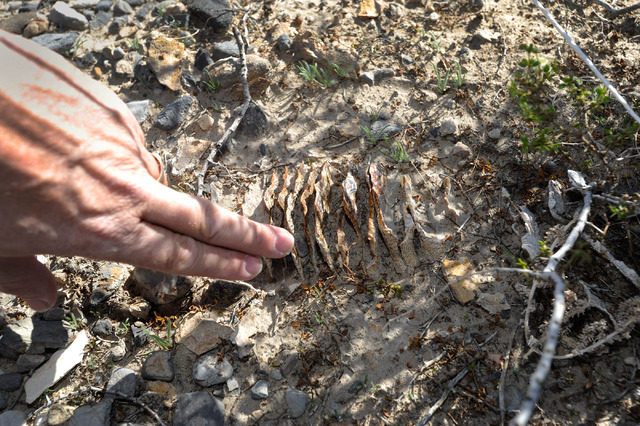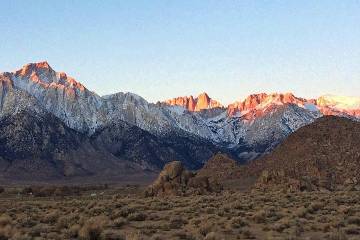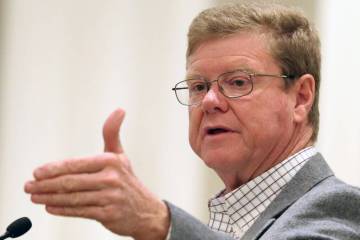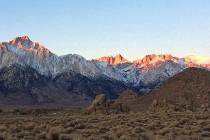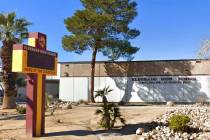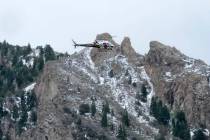House leaders delay votes on Nevada’s Tule Springs monument bill
House leaders agreed to postpone committee votes Thursday on a bill to create a national monument in Southern Nevada after a furor erupted over profits from land sales in the measure, lawmakers said.
Advocates for a bill that would protect ice age fossils at Tule Springs in the hills north of Las Vegas scrambled on Wednesday to head off a last-minute amendment they said could poison the measure.
It was a full-court press: The city of Las Vegas dispatched its government affairs manager to the U.S. Capitol. Members of Nevada’s congressional delegation buttonholed a key subcommittee chairman. Sen. Harry Reid, D-Nev., threatened to kill the legislation outright rather than allow it to pass if it was changed, saying “a bad bill is worse than no bill.”
Even former Sen. John Ensign, who resigned in 2011 and is now a Las Vegas veterinarian, issued a statement of support.
By late Wednesday, Rep. Steven Horsford, D-Nev., said Rep. Rob Bishop, R-Utah, had agreed to postpone Thursday’s action in the House Resources Committee on the public land bill. Bishop, chairman of the public lands subcommittee, was the sponsor of the proposed amendment that set off the controversy when it was made public Wednesday.
“Chairman Bishop said he would work with me now that I know some of their intent, to see how we can reach consensus to move the bill forward,” said Horsford, the sponsor of the Nevada bill. “I want to work with him to see if there is another way to do it.”
Bishop spokeswoman Melissa Subbotin said the situation “is very fluid. They may just not address it in tomorrow’s (meeting).”
Nevada lawmakers and conservationists in the state complained the Bishop amendment would chip away at the state’s lucrative conservation law, the Southern Nevada Public Land Management Act.
Enacted in 1998, that measure allows federal land in the Las Vegas Valley to be auctioned off and the proceeds used for conservation projects in the state. So far the Bureau of Land Management has sold about 15,000 acres for development in the valley and generated roughly $3 billion for everything from Lake Tahoe preservation to construction of parks, trails and visitor centers, mostly in Clark County.
Lake Mead National Recreation Area, the Southern Nevada Water Authority, the Springs Preserve, the Clark County Wetlands Park, the Clark County Shooting Complex and the Neon Museum have all shared in tens of millions of dollars from the sale of public land.
Nevada leaders have zealously guarded the land fund though the years. The Bush administration tried in 2005 and 2006 to divert land act funds into the Treasury but abandoned the push after Reid threatened to block President George W. Bush’s nomination of Dirk Kempthorne as Interior secretary.
More recently, a Republican budget blueprint bill that passed the House last year proposed diverting 70 percent of profits from certain federal land sales to the Treasury. No follow-up bill was passed.
The centerpiece of the Horsford bill would create a 22,650-acre Tule Springs Fossil Bed National Monument at the valley’s northern edge, to be managed by the National Park Service.
But the omnibus bill also reconfigures public lands in other parts of the valley, including transferring 660 acres to Las Vegas and 645 acres to North Las Vegas for “job creation zones.”
The original bill cleared the cities to auction off the land for development, with profits going to the Nevada land fund. Under the proposed amendment, the money would go to the U.S. Treasury instead.
Bishop said Wednesday he personally has no problem with Nevada keeping the proceeds from public land sales. But he said it would be considered an “earmark” banned under House rules put in place in 2010.
“I’m sorry,” Bishop said. “I hate the rule. I think that it’s wrong. It shouldn’t be that when dealing with a land transfer, but it is. If the bill is going to proceed I have to fix that earmark issue.”
The Horsford bill would be at risk of being killed by a “point of order” if it reached the House floor as written, Bishop said. More likely, House Republican leaders wouldn’t bring it up for a vote.
“If there’s a more convenient way of working around it, I’m open to it,” Bishop said.
Reid said he would pull support for the bill if public land profits were diverted.
“Any attempt to support Tule Springs in this form is an attempt to gut (the Southern Nevada Public Land Management Act), and I will not allow nor support these efforts,” the Nevada Democrat said. “A bad bill is worse than no bill at all.”
Ensign, one of the co-authors of the 1998 bill, said “it would be a terrible day for Nevada if funds from SNPLMA get put in the general fund rather than staying in Nevada.”
Lynn Davis, senior Nevada program manager for the National Parks Conservation Association, said the new language targeting the land fund isn’t the only “poison pill” in the amendment. Other proposed changes to the bill also are unwelcome, especially after the measure was painstakingly negotiated by local stakeholders over several years.
“It’s an absolute affront to everyone who has had skin in this game,” Davis said.
Of particular concern to advocates for Tule Springs is a newly added requirement for the National Park Service to conduct a detailed suitability study before taking on management of the new national monument.
Jill DeStefano is president of the local nonprofit Protectors of Tule Springs. She said the BLM has already spent more than $6 million studying the area over the past 10 years. “Why would taxpayers want to see any more money spent on studies?”
Rob Mrowka, who serves on the board of directors for the Protectors of Tule Springs, called Bishop’s amendment a “sneak attack.”
“Is that really the way our government should work?” he said. “For local residents to take the initiative and then at the very end we get slapped down, it’s pretty frustrating and irritating.”
Besides creating Nevada’s only national monument and ceding acreage to the cities, the bill would add land to the Red Rock Canyon National Conservation Area, improve management of the Spring Mountains National Recreation Area, free up property for campus expansion by the Nevada System of Higher Education, and convey land to Clark County for an off-road vehicle recreation park at Nellis Dunes.
Paleontologists regard the fossil beds on the northern edge of the Las Vegas Valley as a treasure trove. The 22,650-acre area is littered with the remains of mammoths, giant sloths, camels and other extinct creatures that roamed between 10,000 and 250,000 years ago, when the desert was green with vegetation.
Local officials see the proposed monument as an attraction for eco-tourists from around the world who might be drawn to Las Vegas from the Grand Canyon and national parks in Utah.
The monument would be bounded by the Desert National Wildlife Refuge, the Red Rock Canyon National Conservation Area and the Spring Mountains National Recreation Area, all of which have received millions of dollars — enough to pay for new visitor centers and more — from property auctions allowed under the Southern Nevada Public Land Management Act.
Review-Journal writer Laura Myers contributed to this report. Contact reporter Henry Brean at hbrean@reviewjournal.com or 702-383-0350. Follow him on Twitter at @RefriedBrean. Contact Stephens Washington Bureau Chief Steve Tetreault at stetreault@stephensmedia.com or 202-783-1760. Follow him on Twitter @STetreaultDC.




